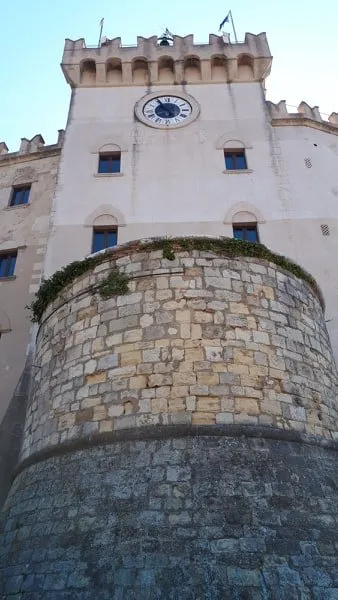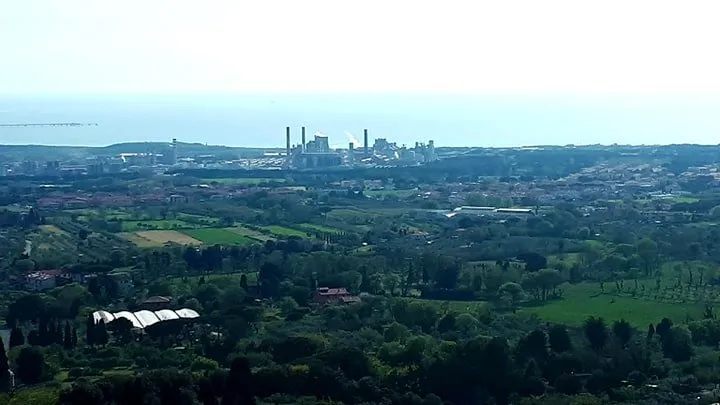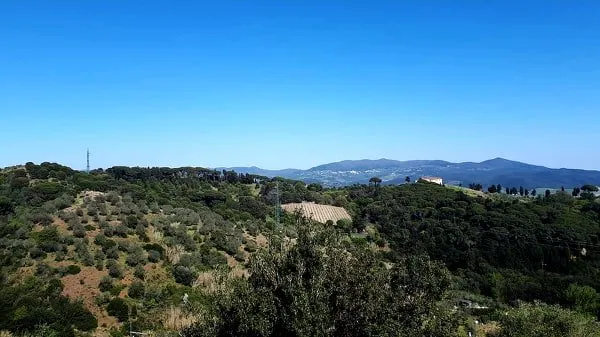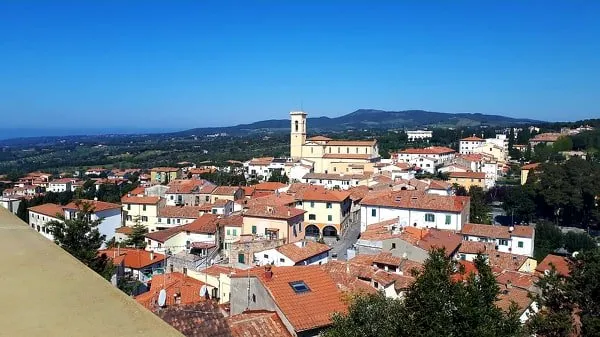
Today I will tell you a little about Rosignano Marittimo, a town in the province of Livorno, in Tuscany. We have been stopping here for some time because of some structural and engine problems that we had to solve urgently and we chose Rosignano because heva's birthplace. And therefore to have support during the work since my family lives in Spain.
La nascita del primo agglomerato è riconducibile ai Romani o agli Etruschi. Da qui nascono le varie teorie sulla derivazione del toponimo. Le principali teorie vedono: una, la famiglia romana dei Rasinii da cui dovrebbe derivare il nome Rasinianus attribuito al paese nel 778 mentre una seconda teoria lo ricollega al nome nazionale Etrusco Rasenna. Di tutt’altra fattura l’aggiunta della specificazione “Marittimo” nel nome per indicare la posizione, che infatti significa “della Maremma” dal nome latino Maritima (1862).
The birth of the first agglomeration is attributable to the Romans or the Etruscans. Hence the various theories on the derivation of the toponym. The main theories see: one, the Roman family of the Rasinii from which the name Rasinianus attributed to the town in 778 should derive. A second theory links it to the national Etruscan name Rasenna. The addition of the "Maritime" specification in the name to indicate the position, which in fact means "of the Maremma" from the Latin name Maritima (1862), is of a completely different invoice.
Il castello, per la sua posizione strategica, è sempre stato al centro di potere e assedi. Venne ristrutturato più volte partendo dal 1046, anno in cui si hanno le prime documentazioni del centro fortificato. Nel 1562, a seguito della distruzione per mano dei corsari Turchi, grazie Cosimo I de Medici, vennero costruite le due torri che si possono ammirare tutt'oggi, e che successivamente, nel XVIII secolo, adibite quella di levante a prigione, mentre quella a ponente a terrazza.
The castle, due to its strategic position, has always been at the center of power and sieges. It was renovated several times starting from 1046, the year in which the first documents of the fortified center are found. In 1562, following the destruction at the hands of the Turkish corsairs, thanks to Cosimo I de Medici, the two towers which can still be admired were built, and which later, in the eighteenth century, used the east one as a prison, while the one west terrace.


Torre di levante adibita a prigione nel XVIII secolo, costruita con pietra calcarea “travertino di Rosignano”.
East tower used as a prison in the eighteenth century, built with limestone "travertine of Rosignano".

Torre di ponente adibita nel XVIII secolo a terrazza costruita ai piedi dell’orologio e del nuovo campanile del castello.
West tower used in the 18th century as a terrace built at the foot of the clock and the new bell tower of the castle.

Castello di rosignano, attuale sede del comune.
Rosignano Castle, current seat of the municipality.

Castello di Rosignano, attuale sede del comune, visto dalla terrazza panoramica, a destra della foto si può notare la torre di ponente.
Rosignano Castle, current seat of the municipality, seen from the panoramic terrace, to the right of the photo you can see the west tower.
Altra tappa della storia di Rosignano è la chiesa del castello, dedicata ai s.s. Ilario e Giovanni Battista. Consacrata nel 1848 ma che fonda le sue origini nel 1524. Nonostante le successive ricostruzioni che risalgono al 1700, anno al cui risale anche l’arco di accesso al castello, rappresentante lo stemma Mediceo. Mentre la cisterna situata nei pressi di Palazzo Bombardieri (attuale museo civico) è di epoca rinascimentale, utilizzata per lo stoccaggio di acqua per il paese.
Another stop in the history of Rosignano is the castle church, dedicated to s.s. Ilario and Giovanni Battista. Consecrated in 1848 but which founds its origins in 1524. Despite subsequent reconstructions dating back to 1700, the year to which the arch of access to the castle also dates, representing the Medici coat of arms. While the cistern located near Palazzo Bombardieri (current civic museum) is from the Renaissance period, used for the storage of water for the town.

Vista da fuori le mura della chiesa di s.s. Ilario e Giovanni Battista (a destra) e dell’arco con lo stemma Mediceo (a sinistra).
View from outside the walls of the church of s.s. Ilario and Giovanni Battista (right) and the arch with the Medici coat of arms (left).

Stemma Mediceo sull’arco di ingresso del castello.
Medici coat of arms on the entrance arch of the castle.


Interno della chiesa di s.s. Ilario e Giovanni Battista, mi ha colpito particolarmente il confessionale incastonato nel muro.
Interior of the church of s.s. Ilario and Giovanni Battista, I was particularly struck by the confessional set in the wall.


Palazzo Bombardieri,attuale sede del museo civico e parte della vecchia cisterna dell’acqua.
Bombardieri Palace, current seat of the civic museum and the old water cistern.
Tra 1800 e 1900, vive a Rosignano Pietro Gori, poeta, giurista e scrittore anarchico. Grazie a lui questo paese acquisisce importanza nei movimenti politici, collegabili probabilmente all’attività politica di Livorno in quel periodo.
La sua posizione strategica pesò sino alla seconda guerra mondiale, dove fu meta di scontri durissimi, tanto da essere soprannominata in alcuni bollettini di guerra “piccola Cassino”.
Between 1800 and 1900, Pietro Gori lives in Rosignano, poet, jurist and anarchist writer. Thanks to him, this country acquired importance in political movements, probably related to the political activity of Livorno in that period.
Its strategic position weighed until the Second World War, where it was the destination of very hard clashes, so much so that it was nicknamed in some "little Cassino" war bulletins.
L’inizio dell'attività commerciale di questa zona si ha tuttavia agli inizi del 1900, con l’apertura della linea ferroviaria Livorno-Vada-Cecina e con l’interesse per la zona da parte di Ernest Solvay, Il quale nel 1913 comincia i lavori per la costruzione dell’attuale fabbrica di bicarbonato e soda solvay. Rapidamente ha dato il via alla costruzione di abitazioni per gli operai della fabbrica acquistando tutti i terreni circostanti. La costruzione crebbe fino alla creazione di un vero e proprio paese diventata, a tutti gli effetti, Rosignano Solvay, frazione del comune di Rosignano Marittimo.
La presenza dello stabilimento ha portato inevitabilmente all’inquinamento, molto pesante, di tutta la zona, la costa è deturpata dagli scarichi della fabbrica a mare creando così le spiagge bianche (anche dette caraibi di Livorno) che devono il nome al colore della sabbia (bianco) dovuto dalla presenza di calcare cotto e tritato finemente (90%) e cloruro di calcio (10%). Tanto da assegnare alla costa livornese il 5 posto per tasso tumorale da inquinamento in Italia.
However, commercial activity in this area began in the early 1900s, with the opening of the Livorno-Vada-Cecina railway line and with interest in the area by Ernest Solvay. Which in 1913 began work on the construction of the current bicarbonate and soda solvay factory. He quickly started building houses for factory workers by purchasing all the surrounding land. The construction grew until the creation of a real town that became, in all respects, Rosignano Solvay, a hamlet in the municipality of Rosignano Marittimo.
The presence of the plant has inevitably led to very heavy pollution of the whole area, the coast is defaced by the factory drains to the sea thus creating the white beaches (also called the Caribbean of Livorno) which owe their name to the color of the sand ( white) due to the presence of cooked and finely chopped limestone (90%) and calcium chloride (10%). So much so as to assign to the Livorno coast the 5th place for cancer tumor rate in Italy.

Vista della fabbrica solvay da Rosignano Marittimo.
View of the solvay factory from Rosignano Marittimo.
Per concludere;
consiglio vivamente di visitare il paese di Rosignano Marittimo dal castello al museo civico, i vari piccoli resti archeologici come il mulino a vento, e il Parco comunale dei Poggetti che vanta una bellissima vista su tutto il paesaggio circostante. Consiglio, nonostante tutto, di visitare anche le spiagge bianche per rendersi conto del danno che questa fabbrica continua, quasi indisturbata, a recare a questa zona.
To conclude;
I highly recommend visiting the town of Rosignano Marittimo from the castle to the civic museum, the various small archaeological remains such as the windmill, and the Poggetti municipal park which boasts a beautiful view of the surrounding landscape. In spite of everything, I recommend that you also visit the white beaches to realize the damage that this factory continues, almost undisturbed, to do to this area.

Vista dalla terrazza panoramica del parco comunale dei Poggetti.
View from the panoramic terrace of the municipal park of Poggetti.

Paese visto dalla terrazza panoramica.
Town seen from the panoramic terrace.

interno del castello.
inside the castle.
Tutte le foto sono di mia proprietà.
All photos are my property.